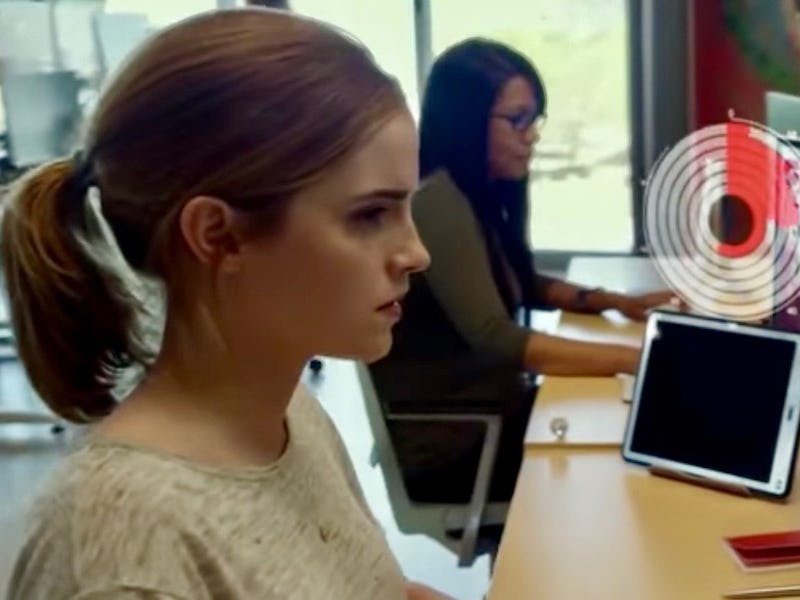How 'The Circle' Director Designed a Social Network From Hell
"A constant angst, a nagging, gnawing feeling in your gut that you're not giving enough."

What sets Dave Eggers’s 2013 novel The Circle apart from other near-future parables is just how real it seems. The book’s dystopia doesn’t have an all-powerful Big Brother or a flashy battle royale between kids; it’s hardly even a dystopia, by the standard definition. Instead, it depicts a culture in which technology begins to overwhelm people, inundating them with endless social media feeds, friend requests, and live broadcast screens. Seen through the eyes of Mae, the book’s young protagonist, those screens are alternately intoxicating and crushing, and that feeling above all else was what writer/director James Ponsoldt wanted to capture in his big screen adaptation.
“I think the anxiety is one of the most palpable things about the book, with the sheer volume of information,” Ponsoldt tells Inverse. “Mae is constantly afraid that she’s gonna be fired. This constant angst, this nagging, gnawing feeling in her gut that she’s not giving enough, that she’s not responding fast enough, that she’s not as transparent, that she’s selfish, that she’s too private, and people want a piece of her.”
In the book, the titular tech company has subsumed all of its rivals and offers a wide range of services, many of which bombard people with text messages, status updates, and demands for interaction; imagine your Facebook and Instagram feed gaining sentience and coming after you at all times. Mae (played by Emma Watson) has up to five computer monitors on her desk, she wears a smart wristband, and her walls are covered in digital screens. Then she takes it to the next level, affixing a small camera to her chest and broadcasting every aspect of her life to millions of viewers, 24 hours a day.
Ponsoldt faced a major dilemma: How do you convey that crush of stimulus and demand for attention without overwhelming the viewer?
“There’s no way she could possibly take all the information in [on screen] — we would all go insane,” he says. “She has things popping up on her screens constantly. She has people that berate her, but mostly it’s sort of a Greek chorus. It was the zings were the thing that felt like something that could be cinematic.”
The “zings” are the equivalent of a Facebook or text message, and they pop up on all of Mae’s screens. So their big screen incarnation had to be simple enough to be shown on a smartwatch while also seeming slightly next-level, but in that streamlined aesthetic that Apple has made so popular. And most importantly, they had to exist on their own, because Ponsoldt wasn’t going to spend a whole lot of time actually showing the screens at Mae’s desk or on her body.
“I thought of something like Sherlock as being a really reliable, sturdy use of text messaging [on screen], just saying, ‘here’s the information,’” he explains. “Most of the tech companies that my friends work at are aggressively idealistic and young and pop-arty; the walls are tagged in some cases. I wanted to show the Greek chorus, the people chiming in that are total strangers from around the world. And I didn’t want it to be grotesque necessarily. I think they were designed to look beautiful, to have some quality of a lens flare or subtle neon.”
Once Mae goes “transparent,” the steady trickle of zings become a biblical downpour, with messages from millions of people flooding her screens at all times. They often have nothing particularly interesting to say — think about the comment sections on YouTube videos or Facebook live streams, taking on lives of their own — but together form an ongoing commentary on her life. There are so many unique voices that pop up ever-so-briefly in that form, and finding the right number of messages to show was one of the more difficult calibrations for the director.
“There were versions where we cluttered the screen, where you could barely see Emma,” Ponsoldt recalls. “And then we pared it back. We realized people were actually reading them. We wanted a perfect picture feeling of what she would feel, which is, ‘Ahhh, even if this is nice, I can’t take it all in.’ I assume that any given scene, if there was an unreadable amount of information, that the goal would be to have two or three that actually are legible.”
That the messages flew on across the landscape on the movie screen, independent of the actual devices that host them, was not just a question of slick aesthetics. In order to make a timeless parable set in the near-present, Ponsoldt needed to hide the exact technology that powers the Circle.
“The movie is a portrait of this character, and not about the company; the company and gadgets are in the backdrop,” he explains. “In a movie that deals with technology in any way, you go into it knowing that whatever technology you picked is going to age. So you don’t want to fetishize the objects and the gadgets. They should fall into the background on the character’s journey.”